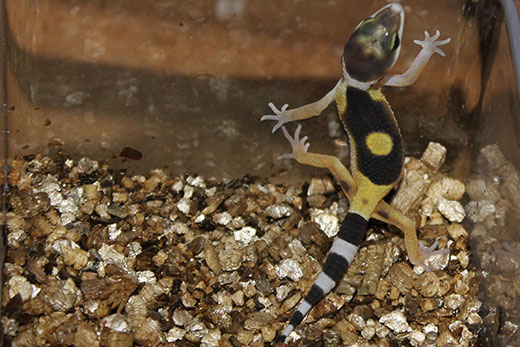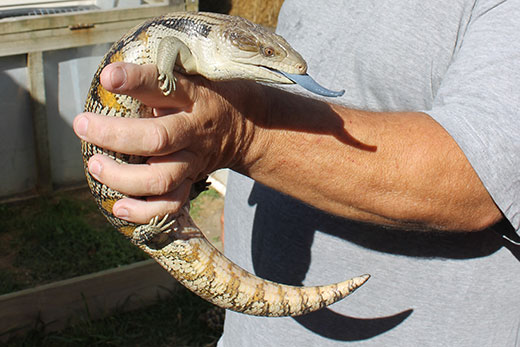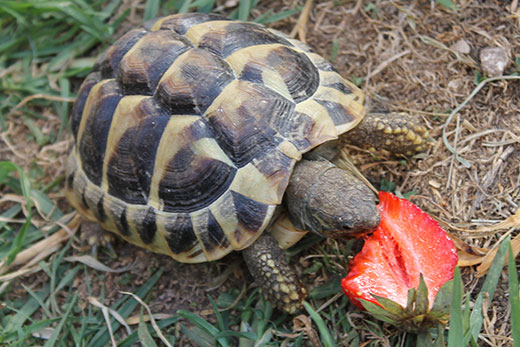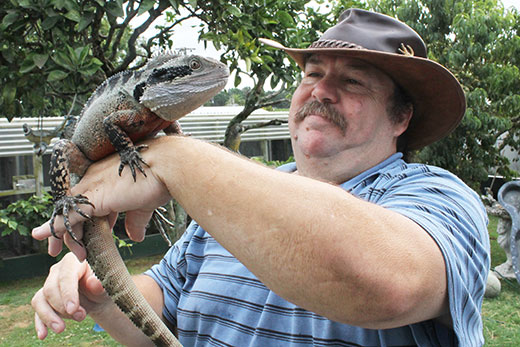Water dragons and snake-necked turtles live in Graeme and Donna Hannah’s backyard – and to keep them well-fed the couple breed meal worms and crickets too.

A young leopard gecko.
“The gene pool in New Zealand is pretty small but we’re trying to increase numbers,” says Donna.
Graeme and Donna know a lot about reptiles – knowledge gained from decades of owning and breeding them.
They invest not only time and money, but most of their outdoor living space to homes for a menagerie of creatures which include Australian lizards, turtles, tortoises, a significant number of birds, as well as guinea pigs, rabbits, even chinchilla. A team of dogs are the ‘guardians’ of them all.

This bearded dragon held by Donna Hannah is moulting and not showing his ‘true colours’.
Kindy visits
However, it’s for the larger lizards Graeme is famous. In Katikati he’s known as ‘The Lizard Man’ by children who meet him and his reptiles at kindergarten or school.
“I like to take the lizards to show children, to talk about them, and let them touch the lizards so children can discover they are not cold, or scary.”
Donna says while most children prefer cuddly pets like puppies, kittens and rabbits, for many lizards have a special appeal.
“Generally, it’s boys fascinated by dinosaurs who are really into lizards.”
It’s the creatures’ links to prehistoric times which account for much of their appeal for both Graeme and Donna.
“This is the closest I’m ever going to get to a dinosaur,” says Graeme, as he strokes the large male water dragon he’s holding, so placid even children can pet it.
Close up its skin is an intricate series of tiny scales in a range of hues, and it’s soft, and certainly not cold to touch. The bearded lizard, with its flattened abdomen, is even more dinosaur-like. It’s moulting and enjoys a scratch to help remove the old skin.
Red necked turtles enjoying life at the Hannah home.
Blue-tongue
The blue-tongue Graeme brings out next has completely different skin – smooth and textured, more like that of snake. Its streamlined, muscular body is snake-like too but its most distinctive feature is the bright blue tongue which flicks in and out almost continuously.
“I think reptiles are absolutely fascinating. Learning to breed and rear them is a challenge too,” says Donna, who is head of the IT department at Tauranga Girls’ College.
Around Graeme and Donna’s feet Hermann’s tortoises move quickly through the grass.
“They think we’ve come to feed them.” Definitely not slow and lumbering, the tortoises, from juveniles to mature adults, emerge from their shelters keen for a treat.
Today it’s strawberries which the ‘babies’ devour, holding them in place with their front claws and nipping at the flesh with their beak-life mouths.
Donna and Graeme can keep exotic creatures without the need for a licence because they are not New Zealand natives.
Some of the lizards they have are Australian, some come from other countries, which include leopard geckos originally from Central Asia.
As well as the Hermann’s tortoise, the couple also have snake neck turtles, reeves turtles and red-necked turtles, these include some more than 20 years old.
Feeding so many reptiles isn’t cheap and to ensure they have the right food, Graeme breeds crickets and meal worms to supplement their diet. 
It’s obvious why this lizard is called a blue tongue.
Hatching eggs
Lizard, turtle and tortoise eggs are hatched in a series of temperature controlled incubators but success isn’t assured. “The first time I tried hatching tortoise eggs I lost all but one out of 17.
“I researched to find out what I’d done wrong and since then we have about a 90 per cent success rate,” says Graeme.
The adult lizards require controlled environments to survive. “I lost a blue tongue and couldn’t figure out why so went online seeking help and got excellent advice from a nine-year-old boy in America, who knew a lot more about lizards than I did.”
Graeme says that’s another things he enjoys about keeping reptiles. There’s an international community of people with the same interests.
Donna and Graeme sell lizards direct, not through pet shops.
“We want to be able to talk to people who are buying them to make sure they understand the animal and have the right equipment to keep and feed them.
“We hate to see animals not looked after properly and it’s also a big disappointment for someone if their pet dies,” says Donna.
Several years ago Graeme was seriously injured in a car crash. It was thought he wouldn’t be able to walk again and he still suffers from back problems.
However, thanks to the support of Donna and their five children, he’s made a remarkable recovery and now caring for and breeding animals is his ‘day job’ and it’s far more demanding than most eight-to-five ones.

Strawberries are among the baby Hermann’s tortoise’s favourite food.
No names
There’s a constant round of feeding and cleaning the pets and their enclosures, as well as socialising with the birds, animals and reptiles.
And yes, says Donna and Graeme, the reptiles do respond to them. “They know us and respond in different ways. Some are happy to be handled, others not so much.”
Graeme’s love of animals goes back to his eighth birthday when his uncle gave him a small flock of pigeons.
The couple have kept birds and pets all their married life and while they were living in Tauranga, helped look after birds and animals for the SPCA.
“At one stage we had so many different animals our place was referred to as Noah’s Ark,” says Donna.
Now their five children have left home, the couple have converted their property into another ark, filled with a strange menagerie of creatures, all of which receive personal attention, but none of which – except the dogs – have names.
“If they are named, they will never leave,” says Graeme.



0 Comments
Leave a Comment